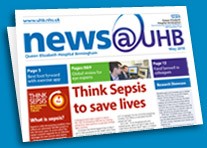Your views

Your feedback is vital to us as we continue to increase the quality of our services.
You are here:
Date: 30 June 2024
Time: 20:17
Communicating dignity in care
Story posted/last updated: 29 November 2012
Visiting hospital can be stressful when you find communicating easy, so imagine what it would be like if you had difficulty seeing, hearing, speaking or understanding spoken language.
With Deaf Awareness Week (2 – 8 May) around the corner, the Dignity in Care Team at Queen Elizabeth Hospital Birmingham (QEHB) has launched a special "communications box" to help patients explain their needs, where an interpreter is unavailable.
Funded by the hospital’s official charity, the box includes a hospital communication book, which has information about how to support people who have difficulty communicating, with pictures that give people choices, explain what is going to happen and help them to communicate with hospital staff and family members. The box also contains a spectacle repair kit, hearing aid batteries, a magnifying glass, pen and notepad, and a hand-held communicator.
Margaret Harries, Dignity in Care Team Leader, explained: “The idea came about after I visited my brother in hospital and found he had difficulty communicating with staff following a tracheostomy procedure.
“We realised that these boxes are vital if patients find themselves without an interpreter and need to contact staff for anything, whether that’s pain medication, a drink or to discuss their care.
"It is also a helpful resource if we need to explain a procedure to a patient. We are grateful to the Queen Elizabeth Hospital Birmingham Charity for funding these boxes and are sure they will be of enormous benefit.”
Henry Skinner, a clinical audit and information officer at University Hospitals Birmingham NHS Foundation Trust, has been deaf from birth and has helped develop the boxes.
Henry said: “I’ve found that many people can be scared of communicating with a deaf person, as they’re not sure what to do. Trying to explain everything becomes stressful for both the patient and the healthcare professional.
"These boxes are a great idea because they enable both parties to relax. The pen and paper, for example, is really useful because healthcare professionals can write things down, enabling the patient to read, digest and understand what is being communicated at their own pace. It also means there is no need to shout, protecting a patient’s privacy.
“The other advantage is that for many deaf people, English is not their first language and so they experience the same translation difficulties as anyone learning a new language. My first taught language is British Sign Language, which has its own grammar and structure. These boxes are an excellent way of breaking down communication barriers in care.”
For more information about how you can support patients being treated at the Queen Elizabeth Hospital Birmingham please call QEHB Charity on 0121 371 4852 or visit their website.
University Hospitals Birmingham NHS Foundation Trust is not responsible for the contents or the reliability of external websites and does not necessarily endorse the views expressed within them. Listing should not be taken as endorsement of any kind. We cannot guarantee that links to other websites will work all of the time, and we have no control over the availability of external web pages.

Getting here
Information about travelling to, staying at and getting around the hospital.

Jobs at UHB
A great place to work. Learn why.
news@UHB


RSS feed
Subscribe to our news feed


